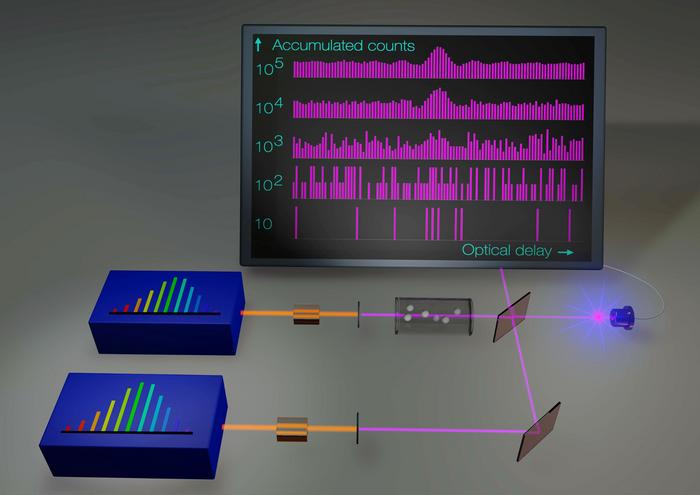Researchers at the Max Planck Institute of Quantum Optics (MPQ) have successfully developed a new technique for deciphering the properties of light and matter that can simultaneously detect and precisely quantify many substances with high chemical selectivity. Their technique interrogates the atoms and molecules in the ultraviolet spectral region at very feeble light levels. Exciting prospects for conducting experiments in low-light conditions pave the way for novel applications of photon-level diagnostics, such as precision spectroscopy of single atoms or molecules for fundamental tests of physics and ultraviolet photochemistry in the Earth’s atmosphere or from space telescopes. The work is published today in the scientific journal Nature.

Credit: Nathalie Picqué / Nature
Researchers at the Max Planck Institute of Quantum Optics (MPQ) have successfully developed a new technique for deciphering the properties of light and matter that can simultaneously detect and precisely quantify many substances with high chemical selectivity. Their technique interrogates the atoms and molecules in the ultraviolet spectral region at very feeble light levels. Exciting prospects for conducting experiments in low-light conditions pave the way for novel applications of photon-level diagnostics, such as precision spectroscopy of single atoms or molecules for fundamental tests of physics and ultraviolet photochemistry in the Earth’s atmosphere or from space telescopes. The work is published today in the scientific journal Nature.
Ultraviolet spectroscopy plays a critical role in the study of electronic transitions in atoms and rovibronic transitions in molecules. These studies are essential for tests of fundamental physics, quantum-electrodynamics theory, determination of fundamental constants, precision measurements, optical clocks, high-resolution spectroscopy in support of atmospheric chemistry and astrophysics, and strong-field physics. Scientists in the group of Nathalie Picqué at the Max-Planck Institute of Quantum Optics have now made a significant leap in the field of ultraviolet spectroscopy by successfully implementing high-resolution linear-absorption dual-comb spectroscopy in the ultraviolet spectral range. This groundbreaking achievement opens up new possibilities for performing experiments under low-light conditions, paving the way for novel applications in various scientific and technological fields.
Dual-comb spectroscopy, a powerful technique for precise spectroscopy over broad spectral bandwidths, has been mainly used for infrared linear absorption of small molecules in the gas phase. It relies on measuring the time-dependent interference between two frequency combs with slightly different repetition frequencies. A frequency comb is a spectrum of evenly spaced, phase-coherent laser lines, that acts like a ruler to measure the frequency of light with extreme precision. The dual-comb technique does not suffer from the geometric limitations associated with traditional spectrometers, and offers great potential for high precision and accuracy.
Dual-comb spectroscopy now available for low light intensities
Nathalie Picqué and some of her team members in one of her dual comb labs at MPQ.
However, dual-comb spectroscopy typically requires intense laser beams, making it less suitable for scenarios where low light levels are critical. The MPQ team have now experimentally demonstrated that dual-comb spectroscopy can be effectively employed in starved-light conditions, at power levels more than a million times weaker than those typically used. This breakthrough was achieved using two distinct experimental setups with different types of frequency-comb generators. The team developed a photon-level interferometer (Fig.1) that accurately records the statistics of photon counting, showcasing a signal-to-noise ratio at the fundamental limit. This achievement highlights the optimal use of available light for experiments, and opens up the prospect of dual-comb spectroscopy in challenging scenarios where low light levels are essential.
The MPQ researchers addressed the challenges associated with generating ultraviolet frequency combs and building dual-comb interferometers with long coherence times, paving the way for advances in this coveted goal. They exquisitely controlled the mutual coherence of two comb lasers with one femtowatt per comb line, demonstrating an optimal build-up of the counting statistics of their interference signal over times exceeding one hour. “Our innovative approach to low-light interferometry overcomes the challenges posed by the low efficiency of nonlinear frequency conversion, and lays a solid foundation for extending dual-comb spectroscopy to even shorter wavelengths”, comments Bingxin Xu, the post-doctoral scientist who led the experiments.
Indeed, an exciting future application is the development of dual-comb spectroscopy at short wavelengths, to enable precise vacuum- and extreme-ultraviolet molecular spectroscopy over broad spectral spans. Currently, broadband extreme-UV spectroscopy is limited in resolution and accuracy, and relies on unique instrumentation at specialized facilities. “Ultraviolet dual-comb spectroscopy, while a challenging goal, has now become a realistic one as a result of our research. Importantly, our results extend the full capabilities of dual-comb spectroscopy to low-light conditions, unlocking novel applications in precision spectroscopy, biomedical sensing, and environmental atmospheric sounding”, Nathalie Picqué concludes.
Journal
Nature
DOI
10.1038/s41586-024-07094-9
Article Title
Near-ultraviolet photon-counting dual-comb spectroscopy
Article Publication Date
6-Mar-2024




